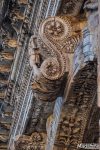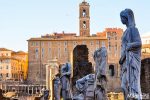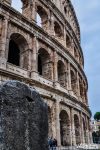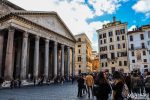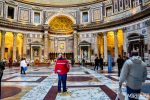Europe is full of relics from its Roman past, whether it’s the imposing Porta Nigra in Trier, Germany, the well-preserved amphitheatre in Nîmes, France or the intimate Palace of Diocletian in Split, Croatia. The Romans practically occupied everything in Western Europe and the Mediterranean and were the rulers of Europe for more than 500 years. What better way to learn their history and walk in their footsteps than to go where it all began. Into the epicentre of Roman civilization. In Rome.
Here, we will discover the most important Roman sights (because everywhere you turn, you’re literally tripping over a 2.000-year-old ruin) that tell an important story and makes the Roman history come alive.
Forum Romanum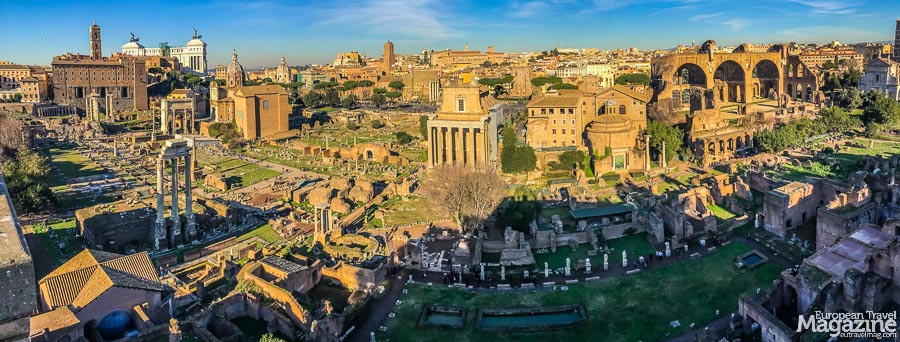
Yup, let’s start with the obvious, because everything emanated from here. This was the heart of ancient Rome, the most celebrated meeting place in the world and in all history.
While Rome is said to be founded on exactly the Palatine Hill, it was generally the seven hills of the area that were first occupied. The middle ground, the flat land in the heart of hills soon became a marketplace where the different tribes would meet and exchange goods. This became the Forum Romanum. The senate gathered here to discuss political matters, they had temples, where people came and made offerings to the gods, and triumphal arches boasted the conquering successes of different emperors. This was really a place to show off the power and wealth of Rome.
Everywhere you go inside the Forum, you encounter epic monuments like the columns of the 2.500 year-old Temple of Saturn, just left of the 700-year younger Arch of Septimius Severus. In the other end of the Via Sacra road, you have the Arch of Titus from 82 AD.
Check out the Temple of Antoninus and Faustina between them on the Via Sacra. The temple was begun in 141 AD as a classic, Roman temple and the only reason why its portico stand well-preserved there today is because it was incorporated into a church, the Chiesa di San Lorenzo in Miranda from 700 AD, you can make out behind the huge columns. Notice how high up the door is. Before the archaeological excavations, this was actually ground level!
- Yup, let’s start with the obvious, because everything emanated from here. This was the heart of ancient Rome, the most celebrated meeting place in the world and in all history.
- While Rome is said to be founded on exactly the Palatine Hill, it was generally the seven hills of the area that were first occupied. The middle ground, the flat land in the heart of hills soon became a marketplace where the different tribes would meet and exchange goods. This became the Forum Romanum
- The senate gathered here to discuss political matters, they had temples, where people came and made offerings to the gods, and triumphal arches boasted the conquering successes of different emperors.
- Everywhere you go inside the Forum, you encounter epic monuments like the 1800-year-old Arch of Septimius Severus.
- In the other end of the Via Sacra road, you have the Arch of Titus from 82 AD.
- Check out the Temple of Antoninus and Faustina between them on the Via Sacra. Notice how high up the door is. Before the archaeological excavations, this was actually ground level!
- The senate gathered here to discuss political matters and they had temples, where people came and made offerings to the gods
- This was really a place to show off the power and wealth of Rome.
- Rome is like an onion of historical layers!
Let’s continue onwards through time to another place nearby, also included in the ticket to Forum. A place that precedes Roman times and where Augustus and the later Caesars built their royal palaces..
- Ticket information (12€ per adult in 2018)
- Forum Romanum on Rome’s official Tourism Website
- Forum Romanum on Wikipedia
Palatino
The Palatine Hill, the Collis Palatium in Latin, is the etymological origin of the english word palace as well as other European languages (Italian palazzo, French palais, German Palast, Danish palads). You can say it’s the Mother of Palaces.
The Roman Republic ended and the Roman Empire began 17 years after the death of Julius Caesar (the bloke who gave July its name), when the senate made his successor, Augustus, the first Roman Emperor in 27 BC. Yes – he’s the one who named the month that comes after July. He settled in a house on top of the Palatine Hill and while his Domus Augusti was somewhat modest, that later emperors built lavish, three-storey palaces with views of Circus Maximus.
The Palace of Domitian, or Flavian Palace as it’s also called because the later emperors belonged to the Flavian Dynasty, was completed in 92 AD. It had everything a true palace should have: a public space (Domus Flavia), green gardens (some claim that the Stadio Palatino was not a stadium, but a sunken garden), heated floors, private palace (Domus Augustana), central heating, cooling fountains and great views.
- The Palatine Hill, the Collis Palatium in Latin, is the etymological origin of the english word palace as well as other European languages
- You can say that this is the Mother of all Palaces.
- Emperor Augustus settled in a house on top of the Palatine Hill and while his Domus Augusti was somewhat modest, that later emperors built lavish, three-storey palaces with views of Circus Maximus
- The Palace of Domitian, or Flavian Palace as it’s also called because the later emperors belonged to the Flavian Dynasty, was completed in 92 AD
- It had everything a true palace should have: a public space (Domus Flavia) and green gardens
- (some claim that this Stadio Palatino was not a stadium, but a sunken garden)
- The palace even had central heating!
- It may be hard to visualize the palatial buildings when you walk among the ruins, which is why we recommend a guide
- A good guide will really make history come alive and explain the layout not only of the area but of the Roman history itself
It may be hard to visualize the palatial buildings when you walk among the ruins, which is why we got a guide that really made history come alive and explained the layout not only of the area but of the Roman history itself. To discover where a dog made a paw-print in the drying cement, to understand how the emperors lived, to witness the place where Julius Caesar’s dead body was brought and sense antiquity being shaped before your eyes, book a guided tour with Eden Walks. Ask for Claudio – he’s a walking encyclopedia with Roman history in his blood!
Fori Imperiali
You might not realise, when you walk along the street of Via dei Fori Imperiali, towards the Colosseum, that the ruins you see on the left are actually not the Roman Forum. It’s the Imperial Fora, built by the Emperors as an extension of the Forum Romanum. The reason for the plural Fori is, that there were 4 of them: Forum of Caesar, Augustus, Nerva and Trajan. The statues you see along the road are the different emperors in front of their respective forums.
As you’ve might have guessed, Caesar was the first to built his Foro di Cesare here, as an extension of the Roman Forum. It’s actually on your right hand side. The three columns you can see are the remains of the temple he erected for the goddess Venus. After his successor, Augustus, had defeated his enemies (that had assassinated Caesar) he swore to build a temple for Mars the Avenger. This was done in Foro di Augusto, which lies behind Caesar’s Forum, to your left. The four white remaining columns of the temple are standing against a large red wall, which functioned as a firewall. Augustus constructed this between the Forum and Suburra; the suburb, located behind the wall in the current Monti neighbourhood, to shield the Forum from the many fires, that used to break out.
- You might not realise, when you walk along the street of Via dei Fori Imperiali, towards the Colosseum, that the ruins you see on the left are actually not the Roman Forum. It’s the Imperial Fora.
- The reason for the plural Fori is, that there were 4 of them: Forum of Caesar, Augustus, Nerva and Trajan.
- As you’ve might have guessed, Caesar was the first to built his Foro di Cesare here, as an extension of the Roman Forum
- The different columns you can see, are the remains of temples
- They are beautifully lit up in the evening.
- We recommend a visit to the Imperial Fora Museum, to appreciate the many artifacts in their authentic environment and catch up on your ancient Roman history
- The museum is located inside the Foro di Traiano or “Trajan’s market” as it was called, because scholars for many years believed it to be an ancient shopping mall.
- The statues you see along the road are the different emperors in front of their respective forums.
The Forum of Nerva to the right of Augustus’ Forum was built almost 100 years later and is the smallest of the fora. The Forum to the far left was the last, called Foro di Traiano or “Trajan’s market” because scholars for many years believed it to be an ancient shopping mall. This beautiful, monumental complex is the best preserved and we recommend a visit to the restored rooms inside the Imperial Fora Museum, to appreciate the many artifacts in their authentic environment and catch up on your ancient Roman history.
- Ticket information: FREE to see from the outside
- Imperial Fora Museum ticket (15€ in 2018)
- Imperial Fora on Wikipedia
Colosseo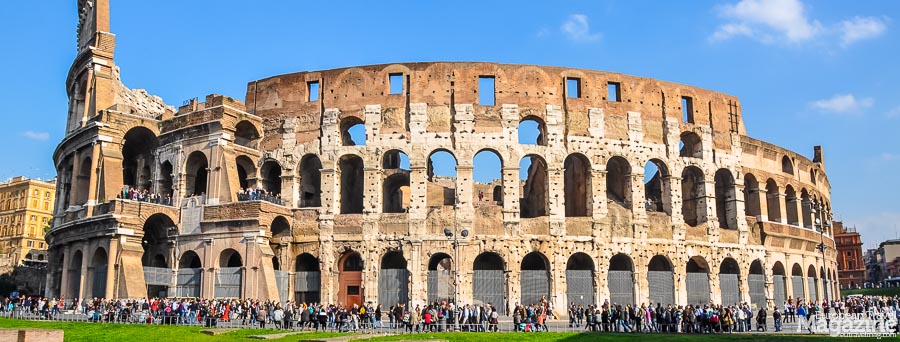
This is not just an arena, or amphitheatre, this is the symbol of Rome itself. So much that it’s depicted on the Italian version of the five-cent Euro coin. Amphi-theatre means “both-sided theatre”, because the Roman theatres were normally semicircular, but when you put two of them together, voila: you have an amphitheatre!
The Colosseum is the largest amphitheatre in the world and it was completed in AD 80 by Titus. He belonged to the Flavian Dynasty and thus the arena used to be called The Flavian Amphitheatre. It’s now know as the Colosseum because there used to be a huuge statue of Nero; the Colossus of Nero, just northwest of the arena.
Back in its heyday it could hold between 50.000 and 80.000 spectators. So many movies have depicted the gladiator battles, executions, enactments of famous battles and dramas that it’s easy to convert the corroded arena to its fabulous former self in one’s imagination. They even had pull-out canopies on top of the Colosseum to provide shade when it was hot. Notice the stones on the eastern side just 15 metres from the arena – they were used to secure and tie the rope used for the canopies.
- They even had pull-out canopies on top of the Colosseum to provide shade when it was hot. Notice the stones on the eastern side just 15 metres from the arena – they were used to secure and tie the rope used for the canopies.
- The Colosseum is the largest amphitheatre in the world and it was completed in AD 80 by Titus. He belonged to the Flavian Dynasty and thus the arena used to be called The Flavian Amphitheatre.
- The may holes in the walls were inflicted during the Middle ages, where people would dig out the metal holding the stones together. Tough times!
- Amphi-theatre means “both-sided theatre”, because the Roman theatres were normally semicircular, but when you put two of them together, voila: you have an amphitheatre!
- This is not just an arena, or amphitheatre, this is the symbol of Rome itself. So much that it’s depicted on the Italian version of the five-cent Euro coin!
- A visit to the Colosseum is included in the Forum ticket. It’s valid for two days, but only for one visit in each site.
- Back in its heyday it could hold between 50.000 and 80.000 spectators
A visit to the Colosseum is included in the Forum ticket. It’s valid for two days, but only for one visit in each site.
- Ticket information (12€ per adult in 2018)
- Colosseum on Rome’s Official Tourism website
- Colosseum on Wikipedia
Circo Massimo
While there may be little left of the grandiosity of former racetrack of Circus Maximus, it doesn’t take much imagination to feel the presence of history here. How the imposing Flavian Palace dominated the one side of the track and the supremacy of the Roman emperors was a powerful presence. It predates the other Roman attractions as it was probably used as a racetrack by the Etruscan kings and in the very early days of the Roman Republic around 500 BC.
- While there may be little left of the grandiosity of former racetrack of Circus Maximus, it doesn’t take much imagination to feel the presence of history here. How the imposing Flavian Palace dominated the one side of the track and the supremacy of the Roman emperors was a powerful presence.
- The name literally means “the largest circus” and large it was! It could accommodate over 150.000 spectators and became the model for circuses throughout the Roman Empire.
- Nowadays it’s a dusty piece of land, popular with dog walkers and the preferred venue for public festivals in Rome.
The name literally means “the largest circus” and large it was! It could accommodate over 150.000 spectators and became the model for circuses throughout the Roman Empire. Nowadays it’s a dusty piece of land, popular with dog walkers and the preferred venue for public festivals in Rome.
- Ticket information: FREE!
- Circus Maximus on Wikipedia
Piazza Navona
Let’s go for walk to another circus in Rome, although it may not be just as recognizable. Let yourself get sucked into the centre of Rome. It’s a 2 kilometre walk though, but it will bring you past some of the most charming areas of Rome, if you walk through the Jewish quarter (great place for a coffee) and Campo dei Fiori (popular hangout for cocktails and aperitivo).
Piazza Navona used to be called Circus Agonalis and over time the name changed to “in avone” to “navone” and finally to “navona”. It was built in the 1st century AD with the official title “Stadium of Domitian” after Emperor Titus Flavius Domitianus, who commissioned it as a gift for the people of Rome.
While urban construction swallowed much of the Roman architecture, it’s the same for Piazza Navona as for everything else in Rome: They became part, albeit many times just as foundation, for new buildings. In Piazza Navona you can visualize its glorious past in its present u-shape, and if you take a peak on the northern side of the square’s outer face, you can see – and visit – the original foundations of this once magnificent Roman circus.
- Piazza Navona used to be called Circus Agonalis and over time the name changed to “in avone” to “navone” and finally to “navona”.
- It was built in the 1st century AD with the official title “Stadium of Domitian” after Emperor Titus Flavius Domitianus, who commissioned it as a gift for the people of Rome.
- While urban construction swallowed much of the Roman architecture, it’s the same for Piazza Navona as for everything else in Rome: They became part, albeit many times just as foundation, for new buildings
- In Piazza Navona you can visualize its glorious past in its present u-shape
- And if you take a peak on the northern side of the square’s outer face, you can see – and visit – the original foundations of this once magnificent Roman circus.
- Today, another circus takes place everyday at Piazza Navona: the Circus of Life.
- It’s a wonderful place to have a glass chilled Frascati white wine and watch the world go by.
Today, another circus takes place everyday at Piazza Navona: the Circus of Life. It’s a wonderful place to have a glass chilled Frascati white wine and watch the world go by. The restaurants flanking the sides of the square are expensive, as you would expect from a popular piazza, but again: how often are you in Rome to indulge?
- Ticket information: FREE! (but add expenses for gelato)
- Visit the archeological foundations of Stadium of Domitian
- Piazza Navona on Wikipedia
Pantheon
Like Piazza Navona, Pantheon is such an integral part of the urban landscape of Rome, that it’s easy to forget that this ancient structure is actually 1900 years old! Pantheon means Temple of God and it used to function as Roman temple before it was converted into a Christian church in 609.
Like many other temples throughout Italy, the building’s consecration as a church saved it from the demolishment, that most ancient buildings suffered during the early Middle Ages. When you enter the very Roman-looking portico with its imposing columns, you enter the rotunda, a structure not commonly found in Europe in this large scale, with a so-called oculus in the top.
The most impressive feature of the Pantheon is its dome-shaped concrete roof, weighing a whopping 4.535 tons. It still holds the record for the world’s largest unreinforced concrete dome. Its dimensions are poetry for mathematicians: the height to the oculus and the diameter of the interior circle are the same, which means that a sphere would fit in here. Five rows of 28 sunken panels, or coffers, of diminishing size radiate from the central oculus, performing a visual trick that makes the dome look higher than it actually is. So unrivalled is its engineerical achievement, that’s even Brunelleschi modelled the dome of Florence’s cathedral after Pantheon. 1300 years after.
- Like Piazza Navona, Pantheon is such an integral part of the urban landscape of Rome, that it’s easy to forget that this ancient structure is actually 1900 years old!
- Pantheon means Temple of God and it used to function as Roman temple before it was converted into a Christian church in 609.
- Like many other temples throughout Italy, the building’s consecration as a church saved it from the demolishment, that most ancient buildings suffered during the early Middle Ages.
- When you enter the very Roman-looking portico with its imposing columns, you enter the rotunda, a structure not commonly found in Europe in this large scale, with a so-called oculus in the top.
- The most impressive feature of the Pantheon is its dome-shaped concrete roof, weighing a whopping 4.535 tons. It still holds the record for the world’s largest unreinforced concrete dome.
- The Pantheon is so unrivalled in its engineerical achievement, that’s even Brunelleschi modelled the dome of Florence’s cathedral after Pantheon. 1300 years after.
- The Pantheon and its surrounding Piazza della Rotonda is the living, beating heart of Rome.
- While Piazza Navona is exclusively populated by tourists, this square still belongs to the Romans and has a wonderful boisterous feel about it
- The prices at the many restaurants are – of course – higher than elsewhere, but you can always sit by the fountain, like million of people before you, have a gelato and contemplate the Eternal City that is Rome.
The Pantheon and its surrounding Piazza della Rotonda is the living, beating heart of Rome. While Piazza Navona is exclusively populated by tourists, this square still belongs to the Romans and has a wonderful boisterous feel about it. The prices at the many restaurants are of course higher than elsewhere, but you can always sit by the fountain, like million of people before you, have a gelato and contemplate the Eternal City that is Rome.
- Pantheon on Wikipedia
- Pantheon on Rome’s official Tourism website
- Information about the Pantheon on a tourism website
If you want to discover more about Rome, how about a free, self guided tour through the streets and into some wonderful churches in the Footsteps of Robert Langdon: Among Angels and Demons (psst, if you’re standing in the Pantheon you’ve already started!). Or if you’re keen on a more recent version of history, check out our guide to Three World War II Sites in Rome.
More info:
- Rome’s Official Tourism website
- Eden Walks guided tours
- Ancient Rome on Wikipedia
- History of the Roman Republic on Wikipedia
- History of the Roman Empire on Wikipedia
Discover more
Get under the skin of Rome by staying here a bit longer than just one week. We can strongly recommend Crib Med for medium-term rentals in the eternal city.
Learn more




